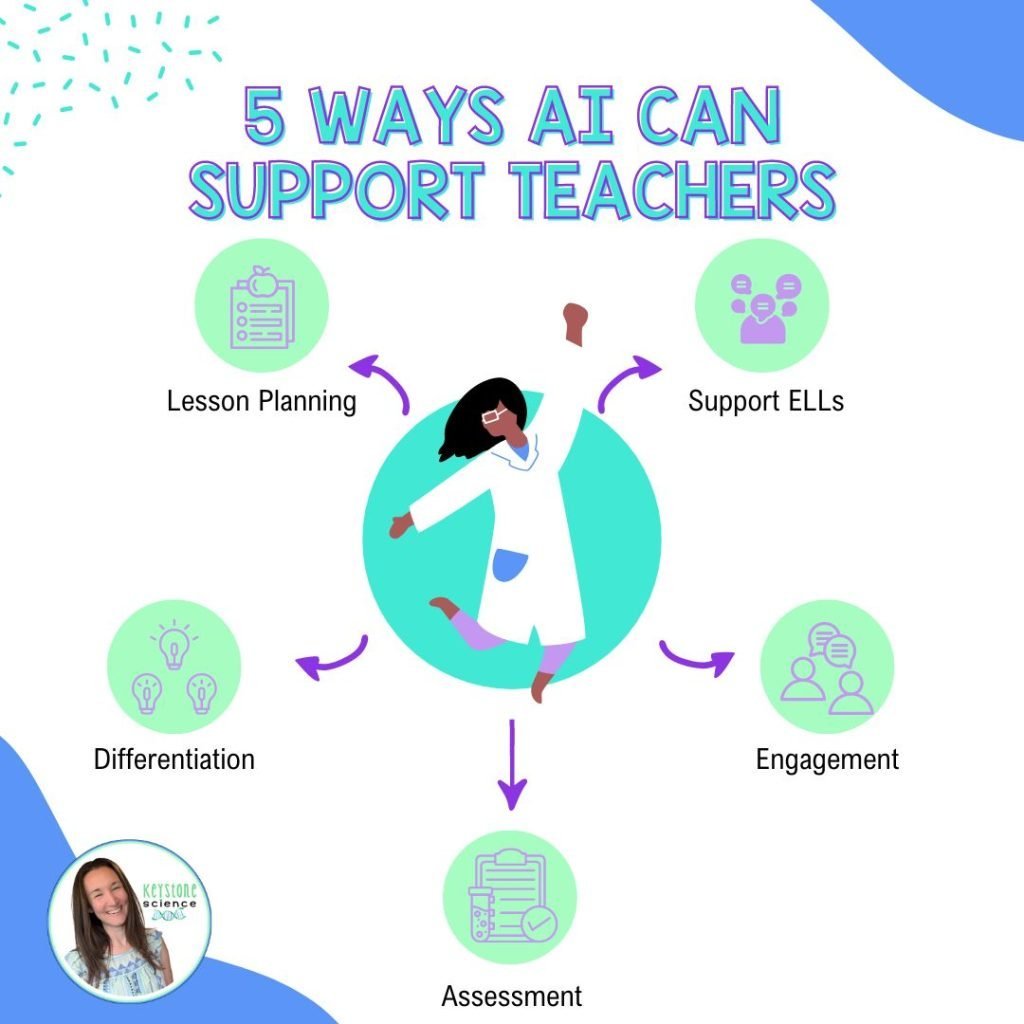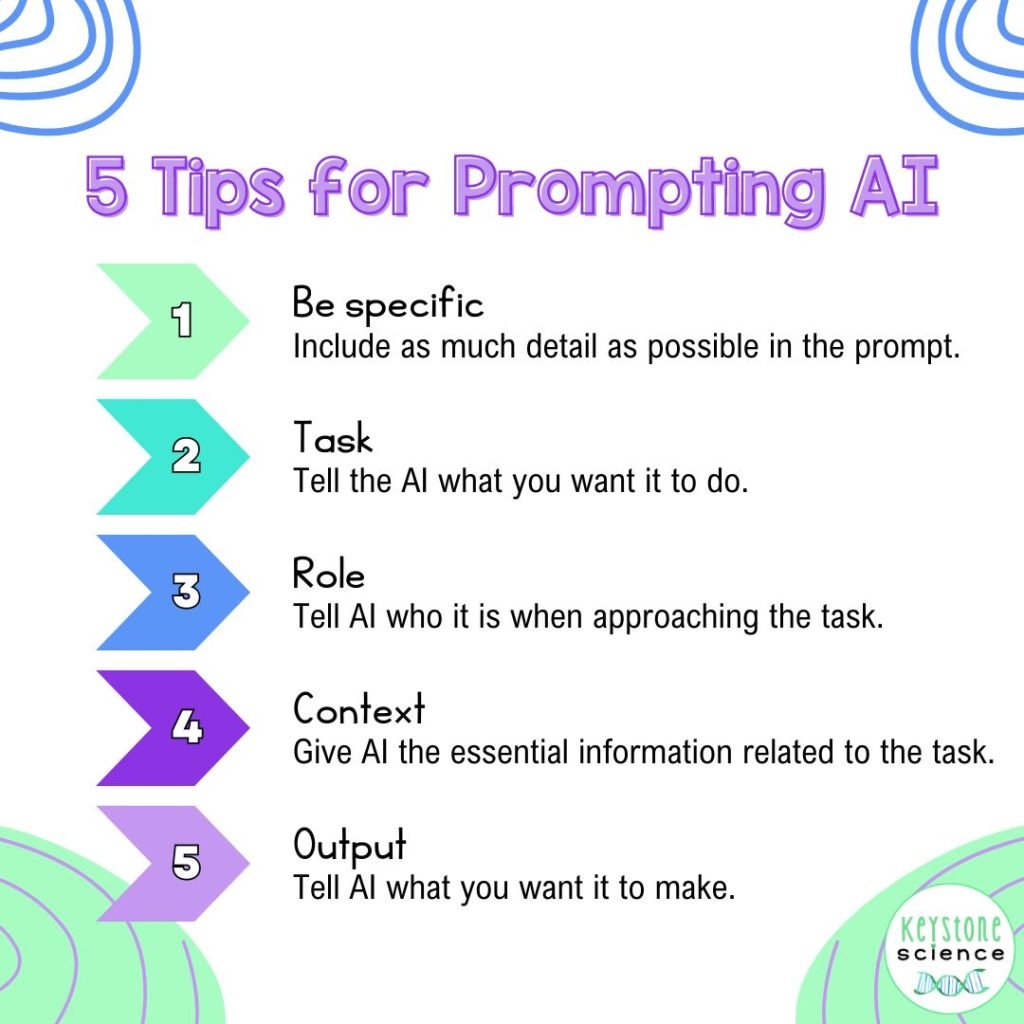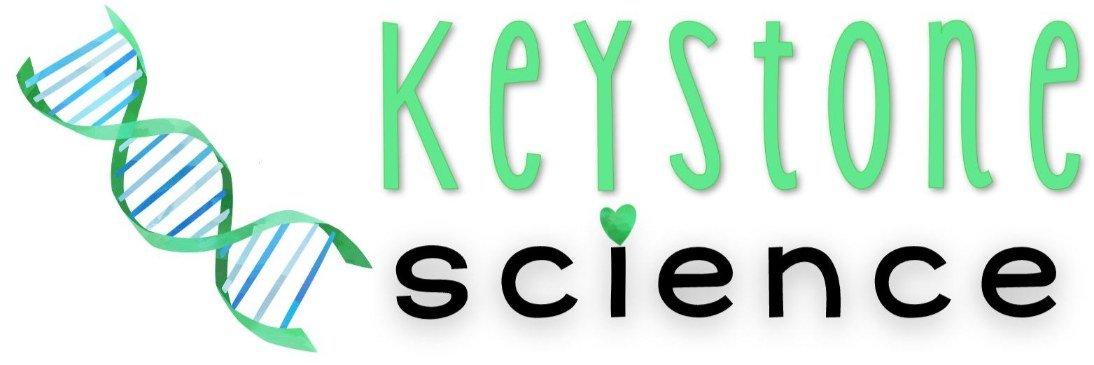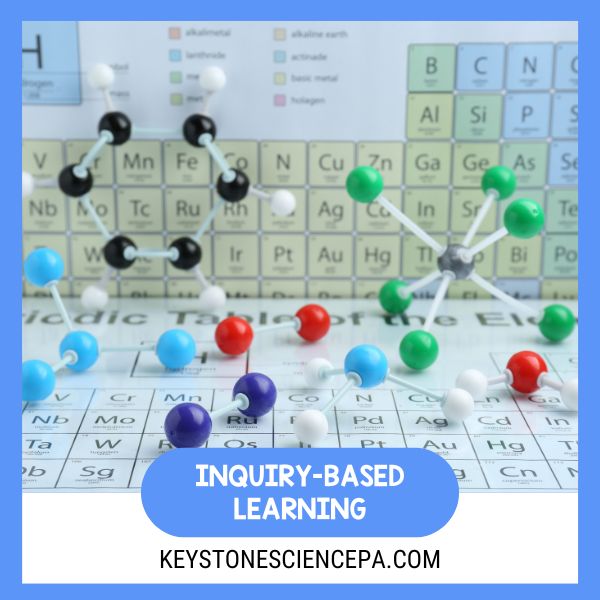In this next blog in my September series on scientific literacy, I am shifting from language to technology literacy. AI is a new and constantly evolving technology that will continue to take a larger and larger role in education and the careers our students will pursue after high school. Being familiar with and using AI prompts effectively is the easiest and fastest way to increase YOUR productivity. Teaching our students AI prompts can make them better students, effective communicators, and critical thinkers.
Introduction
Ever feel like there aren’t enough hours in the day to plan, differentiate, engage, assess, and—oh yeah—actually teach? Enter AI, my not-so-secret weapon in the classroom. With tools like ChatGPT, Co-Pilot, Gemini, or Apple Intelligence, you can streamline your workflow, increase student engagement, and still have time for that cup of coffee you’ve been reheating since 7 AM. I’ve got AI Prompts for everything!
This blog isn’t about jumping on the tech bandwagon for the sake of it. It’s about showing you how AI can genuinely transform your teaching practices—helping you save time, keep students engaged, and even teach them a thing or two about responsible AI use along the way. Let’s explore why AI prompts are the key to effectively saving time and brain power in your classroom. As an extra bonus, I’m sharing 50 AI prompts that will make your life as an educator (and your students’ learning journey) just a tad easier.
The Importance of AI Literacy in Education
Why AI Literacy Matters
In our tech-driven world, understanding AI is no longer optional—it’s essential. AI isn’t just for Silicon Valley engineers; it’s reshaping how we teach and how students learn. By becoming AI-literate, you’re not just adding another tool to your toolbox; you’re preparing yourself and your students for the future. You’re equipping them with the skills they need to thrive in a world where technology is woven into the fabric of everyday life.
Ethical and Responsible AI Use
Now, with great power comes great responsibility (thanks, Uncle Ben!). As educators, we have a duty to use AI tools like ChatGPT ethically. It’s important to ensure that both we and our students understand the potential risks and benefits. That means modeling responsible AI use and teaching students to do the same. Remember, just because we can use AI doesn’t mean we always should. It’s about finding that balance and using these tools to support learning in the best way possible.
How ChatGPT Can Support AI Literacy
Using ChatGPT isn’t just a shortcut to getting things done; it’s a learning opportunity in itself. By integrating AI prompts into your classroom, you’re not only saving time but also helping students understand how AI prompts work and how they can be used in education. You’re fostering a deeper understanding of the technology that’s shaping our world, one prompt at a time.
25 Essential AI Prompts for Teachers

Streamlining Lesson Planning
Let’s face it—lesson planning can sometimes feel like a never-ending task. But with the right AI prompts, ChatGPT can help you generate ideas, create discussion questions, and even design engaging activities, giving you more time to focus on what really matters—teaching.
- Create a lesson plan outline for introducing the concept of [CONCEPT/TOPIC] to [GRADE LEVEL] students.
- Generate five discussion questions on the topic of [TOPIC] for [GRADE LEVEL] students.
- Design an engaging activity to help [GRADE LEVEL] students understand [CONCEPT].
- What are some creative ways to teach [TOPIC] to [GRADE LEVEL] students?
- Outline a lab activity that demonstrates [TOPIC].
Differentiated Instruction
There are so many AI prompts that can create customized resources for students at different learning levels, helping you provide personalized support to ELL students, advanced learners, and students needing extra help.
- Create a simplified version of this lesson on [TOPIC] for students who are still building foundational skills.
- Generate higher-order thinking questions on [TOPIC] for advanced learners to challenge their critical thinking.
- Develop a scaffolded activity that helps struggling students grasp the concept of [CONCEPT/TOPIC] step by step.
- Design a hands-on project related to [TOPIC] for kinesthetic learners to better understand the material.
- Provide multiple-choice questions and open-ended questions on [TOPIC] that can be used in stations for different ability levels.
Supporting ELL Students
Simple AI prompts can translate materials into multiple languages and provide simplified explanations of complex topics, making it easier for teachers to meet the diverse linguistic needs of their students.
- Simplify the explanation of [CONCEPT] for ELL students, using clear language and visuals.” – You can also paste the learning objective or standard to get a better response.
- Translate this science vocabulary list into [target language] and include an English definition for each term.” – Also, ask it to translate definitions into the student’s native language and give the English vocab word.
- Create a graphic organizer to help ELL students understand the relationship between [CONCEPT 1] and [CONCEPT 2].
- Write a short summary of [TOPIC] in easy-to-understand English for WIDA level 1 and 2 ELL students.
- Generate sentence frames that ELL students can use to explain their understanding of [TOPIC].
Enhancing Student Engagement
If you’re running low on inspiration and your students are just not engaging, there are some AI prompts that can help you generate new ideas for creative activities, customize content for different learning styles, and make real-world connections that bring the material to life.
- Generate a list of real-world examples to explain the concept of [CONCEPT/TOPIC] to [GRADE LEVEL] students.
- What are some interactive activities to help [GRADE LEVEL] students understand [TOPIC]?
- How can I adapt a lesson on [TOPIC] for visual, auditory, and kinesthetic [GRADE LEVEL] learners?
- Create a classroom debate topic related to [TOPIC] and its global or local impacts.
- What are some ways to connect the principles of [SUBJECT OR TOPIC] to everyday activities?
Assessing Student Understanding
Assessing student learning doesn’t have to be a chore. With ChatGPT, you can quickly generate formative assessments, quiz questions, and personalized feedback, making it easier to gauge how well your students are grasping the material.
- Create a 10-question quiz on [TOPIC] for [GRADE LEVEL] students.
- Generate a list of open-ended questions to assess [GRADE LEVEL] student understanding of [TOPIC].
- Create a rubric worth [POINT VALUE] to assess [GRADE LEVEL] students lab report on [TOPIC].” – You can also include categories of rubric and specify point value or weight of each.
- Design a formative assessment to gauge understanding of [TOPIC].
- What are some creative ways to assess student learning in a unit on [TOPIC]?
25 Essential AI Prompts for Students

Developing Critical Thinking Skills
Critical thinking is the cornerstone of scientific inquiry. With the right prompts, ChatGPT can help students hone their ability to analyze complex topics, explore multiple perspectives, and develop well-reasoned arguments.
- Analyze the impact of [CAUSE] on [EFFECT].
- What are the pros and cons of using [TECHNOLOGY] in [FIELD]?
- Debate the ethical implications of [ISSUE] in modern science.
- Explore the different [SCIENCES OR MODELS] and [CONTENT]. – As an example, students can prompt AI for: “Explore the different science disciplines and the evidence of evolution in each area.” OR “Explore the different atomic models and the accuracy of each on our current understanding of atomic structure.”
- Discuss the role of [TECHNOLOGY] in combating/preventing climate change.
Enhancing Writing and Communication
Good writing isn’t just about stringing words together; it’s about clear communication. These prompts help students brainstorm ideas, refine their drafts, and express their thoughts with clarity and confidence.
- Create a summary of the main points from [SCIENTIFIC ARTICLE OR WEBSITE] on [TOPIC].
- Brainstorm ideas for a research paper on the effects of [TOPIC] on [CONTENT].
- Write a persuasive essay arguing for or against the use of [CONTROVERSIAL ISSUE].
- Generate an outline for a presentation on the importance of [TOPIC].
- How can I improve the clarity and flow of my lab report on [TOPIC]?
Using it as a Personal Tutor
AI tools can adapt to each student’s learning style, pace, and needs. By analyzing performance, AI can provide tailored lessons, practice problems, or recommendations for improvement, allowing students to progress at their own speed.
- Can you explain [CONCEPT] to me in simpler terms?
- I’m struggling with [TOPIC], can you suggest a study plan or resources to help me improve?
- Can you explain the difference between [CONCEPT 1] and [CONCEPT 2]?
- Generate a set of flashcards for these vocabulary words: [LIST WORDS].
- Can you create a quiz on [TOPIC] to help me study?
Language Support for ELL Students
AI can translate lesson materials and simplify complex language for students with limited English proficiency, making content more accessible. Tools can also provide instant feedback on writing, helping students improve their language skills.
- Can you translate this sentence from English to [native language] for me?
- Explain what [English WORD/PHRASE] means in simple words.
- Can you help me practice my English by giving me sentences to complete?
- How do I pronounce [English word or phrase] correctly?
- Can you write a short paragraph about [TOPIC] that I can use to practice reading in English?
Encouraging Ethical and Responsible AI Use
As we integrate AI into the classroom, it’s crucial to teach students about its ethical use. These prompts encourage students to think critically about the implications of AI and how it can be used responsibly.
- Reflect on the ethical considerations of using AI in healthcare.
- Discuss how AI might impact jobs in the future and what that means for society.
- Explore the potential benefits and risks of AI in environmental conservation.
- What are some ways AI can be used to promote social good?
- Analyze the role of AI in modern warfare and its ethical implications.
Effectively Prompting AI for Better Responses
One of the keys to using AI tools successfully to save yourself time or teach your students how to use AI is learning how to effectively prompt the AI to get the best possible responses. Just like crafting good questions for your students, the way you phrase your prompt greatly influences the quality and accuracy of the AI’s answer. Here are a few tips for prompting AI more effectively:

- Be Specific: The more detailed your prompt, the more likely the AI will give a useful response. For example, instead of asking, “Explain mitosis,” you might say, “Provide a step-by-step explanation of the stages of mitosis, focusing on what happens to the chromosomes in each stage.”
- Task: This is what you want the AI to do. The task could be any one of the prompts in this blog post.
- Role: I ALWAYS tell the AI tool Im working with who I am and what I do. This enhances the coherence and relevance of the AI response.
- Context: This is really helpful for the AI; imagine asking your students to write a paragraph on the properties of water without any additional information or context. You would NOT get good paragraphs! Give the AI the essential information related to the task; this could be the standard or learning objective.
- Output Format: This is how you want the AI to give you its response. Do you want it written? In a bulleted list? In a table? Include this in the prompt to get the best output or follow-up your initial prompt with an additional prompt asking for a specific format.
Remember, if you don’t get the response you want to first time, ASK AGAIN! Follow-up with an additional prompt to clarify or adjust the answer. You could say, “Rewrite the explanation using simpler language,” or “Expand the response to include more details on [TOPIC].”
Also, if you aren’t sure how to prompt the AI, ASK IT! Your prompt could be: “I am a high school science teacher writing a lab that is NGSS-aligned to [STANDARD] and need help starting. Give me some prompts to help me plan the lab and write the student handout.” Have a back and forth “conversation” with the AI tool so you know it has the information it needs to best help you.
Tips for Teachers on Implementing AI in the Classroom
Integrating AI with Traditional Teaching Methods
AI isn’t here to replace you (and thank goodness for that!). It’s a tool to complement your expertise and make your teacher life easier. Use AI to streamline tasks, but remember that your intuition, creativity, and personal connection with students are irreplaceable.
Teaching Students About AI Literacy
AI literacy isn’t just for techies; it’s for everyone. Make sure your students understand the potential and limitations of AI tools. Encourage discussions about AI ethics, responsibility, and digital citizenship, helping them navigate the complexities of this new technology. To help you introduce AI to your high school students, I made a Canva presentation (embedded below) that you are welcome to use with your classes. My students appreciate the clarity the presentation provides and that I am talking to them about something that has been treated as taboo. We are doing our students a disservice by ignoring this technology or pretending it doesn’t exist.
If you want your own editable copy in Canva of the presentation above click this link.
Fostering a Culture of Inquiry and Innovation
Create a classroom environment where curiosity and innovation thrive. Encourage students to ask questions, explore new tools and custom GPTs offered through ChatGPT, and think critically about the technology they’re using. After all, the future belongs to the curious.
Conclusion
AI literacy is more than just a buzzword; it’s a crucial skill for today’s educators and students. By using the 50 ChatGPT prompts provided, you can save time, become a more effective teacher, and help your students succeed in a rapidly changing world. If you want a quick reference list of all the prompts shared in this blog post I made two Google docs, one with the teacher prompts and one with the student prompts.
Ready to give it a try? Start integrating these AI prompts into your classroom practices today! And don’t forget to share your experiences—let’s keep the conversation going on how we can use AI responsibly and effectively in education.
As AI continues to evolve, so must our approach to teaching. By embracing tools like ChatGPT, we’re not only enhancing our teaching efficiency but also preparing our students for success in an AI-driven future. Let’s keep learning, growing, and adapting—together.
Let’s Connect!
💡Feel free to explore Keystone Science for ready-to-use high school biology & ecology NGSS aligned notes and activities.
💡Subscribe to my email list for weekly tips direct to your inbox.
💡Follow me on Instagram for daily tips, motivation, and facts you can use in your classroom!
🌟Share in the comments or email me directly 👉🏻 [email protected]













